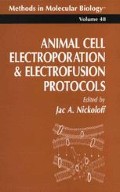Abstract
In early work to produce identical animals, such as twins, triplets, or quadruplets, blastomeres of two- to four-cell stage sheep embryos were separated (1), and each blastomere was sealed in an empty zona pellucida, embedded in agar gel, and temporarily cultured in vivo in rabbit or sheep oviducts until the blastocyst stage. Developed embryos derived from separated blastomeres were recovered 4–5 d later, and transferred into final recipients. However, when producing more than eight identical animals, the developmental ability of the separated blastomere at the 16 to 32-cell stage was quite low, probably because of a shortage of cytoplasmic material. Later, the technique of nuclear transplantation into enucleated oocytes was developed to compensate for the shortage of cytoplasm. Production of cloned animals by nuclear transfer has been reported in many mammalian species, including the mouse (2–5), rabbit (6), sheep (7), cattle (8,9), and pig (10).
Access this chapter
Tax calculation will be finalised at checkout
Purchases are for personal use only
References
Willadsen, S. M. (1979) A method for culture of micromanipulated sheep embryos and its use to produce monozygotic twins. Nature 277, 298–300.
McGrath, J., and Solter, D. (1983) Nuclear transplantation in the mouse embryos by microsurgery and cell fusion. Nature 220, 1300–1302.
McGrath, J. and Solter, D. (1983) Nuclear transplantation in mouse embryos. J. Exp. Zool. 228, 355–362.
McGrath, J., and Solter, D. (1984) Inability of mouse blastomere nuclei transferred to enucleated zygotes to support development in vitro. Science 226, 1317–1319.
Tsunoda, Y., Yasui, T., Shioda, Y., Nakamura, K., Uchida, T., and Sugie, T. (1987) Full term development of mouse blastomere nuclei transplanted into enucleated two-cell embryos. J. Exp. Zool. 242, 147–151.
Stice, S. L., and Robl, J. M. (1988) Nuclear reprogramming in nuclear transplant rabbit embryos. Biol. Reprod. 39, 657–664.
Willadsen, S. M. (1986) Nuclear transplantation in sheep embryos. Nature 320, 63–65.
Robl, J. M., Prather, R., Barnes, F., Eyestone, W., Northey, D., Gilligan, B., and First, N. L. (1987) Nuclear transplantation in bovine embryos. J. Anim. Sci. 64, 642–647.
Prather, R. S., Barnes, F. L., Sims, M. M., Robl, J. M., Eyestone, W. H., and First, N. L. (1987) Nuclear transplantation in the bovine embryo; assessment of donor nuclei and recipient oocyte. Biol. Reprod. 37, 859–866.
Prather, R. S., Sims, M. M., and First, N. L. (1989) Nuclear transplantation in early porcine embryos. Biol. Reprod. 41, 414–418.
Dulbecco, R. and Vogt, M. (1954) Plaque formation and isolation of pure lines with poliomyelitis viruses. J. Exp. Med. 99, 167–174.
Brackett, B. G., and Oliphant, G. (1975) Capacitation of rabbit spermatozoa in vitro. Biol. Reprod. 12, 260–274.
Mitani, T., Utsumi, K., and Iritani, A. (1993) Developmental ability of enucleated bovine oocytes matured in vitro after fusion with single blastomeres of eight-cell embryos matured and fertilized in vitro. Mol. Reprod. Dev. 34, 314–322.
Kato, H., and Iritani, A. (1993) In vitro fertilization in cattle. Mol. Reprod. Dev. 36, 229–231.
Goto, K., Iwai, N., Takuma, Y., and Nakanishi, Y. (1994) Viability of one-cell bovine embryos cultured in vitro: comparison of cell-free culture with co-culture. J. Reprod. Fertil. 100, 239–243.
Quinn, P., Barros, C., and Whittingham, D. G. (1982) Preservation of hamster oocytes to assay the fertilizing capacity of human spermatozoa. J. Reprod. Fertil. 66, 161–168.
Zimmermann, U., and Vienken, J. (1982) Electric field-induced cell-to-cell fusion. J. Membrane Biol. 67, 165–182.
Zimmermann, U. (1982) Electric field-mediated fusion and related electrical phenomena. Biochem. Biophys. Acta 694, 227–277.
Wolfe, B. A., and Kraemer, D. C. (1992) Methods in bovine nuclear transfer. Theriogenology 37, 5–15.
Rosenkrans, C. F., and First, N. L. (1994) Effect of free amino acids and vitamins on cleavage and developmental rate of bovine zygotes in vitro. J. Anim. Sci. 72, 434–437.
Author information
Authors and Affiliations
Editor information
Editors and Affiliations
Rights and permissions
Copyright information
© 1995 Humana Press Inc.
About this protocol
Cite this protocol
Iritani, A., Mitani, T. (1995). Nuclear Transfer in Bovine Embryos. In: Nickoloff, J.A. (eds) Animal Cell Electroporation and Electrofusion Protocols. Methods in Molecular Biology, vol 48. Humana Press. https://doi.org/10.1385/0-89603-304-X:317
Download citation
DOI: https://doi.org/10.1385/0-89603-304-X:317
Publisher Name: Humana Press
Print ISBN: 978-0-89603-304-7
Online ISBN: 978-1-59259-535-8
eBook Packages: Springer Protocols

